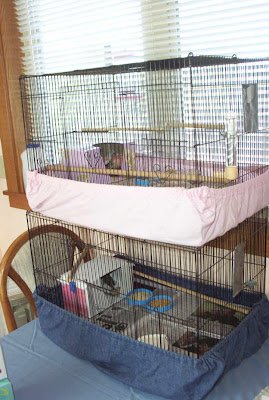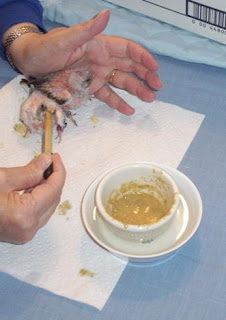I've hesitated to post about this, waiting to see how successful it would be. But, I've decided to go ahead. We have two eggs that are due to hatch in 3-4 days and another that is fertile and should hatch (hopefully) much later.
Thirteen days ago I retrieved five Lady Gouldian eggs that were being ignored by the parents. This after I'd already thrown away 17 she had laid earlier and didn't keep warm. I removed the box and she laid more on the floor of the cage. Two were damaged, but two were not, so they were also retrieved.
 |
Seven Lady Gouldian eggs we are attempting to incubate when parents
didn't. Actually, we only expect three of them to possibly hatch, but
see no reason to give up on the others right away. |
My husband brought up the homemade incubator he'd put together several years ago. At that time, we had tried incubating two Bourke eggs from a hen who had been egg bound. With treatment she survived and went on the following year to lay more eggs. However, none of her eggs ever hatched, including the two we tried to incubate. Yet, they did mature right up to the day they should have hatched, just like her own eggs did the following two years. Some genetic abnormality, perhaps?
Back to the Lady Gouldian eggs. Two babies are moving in their shells and I've quit turning them as instructed at several websites. One of the best I found on incubation and egg repair appears to be this one:
http://www.gouldianfinch.info/breeding/eggs.htm
This time we created a humidifier thermometer to check humidity. That thermometer is in the blue box with a shoelace extended into the bowl of water below. This process was explained on a website we found.
The temp. in the box has been about 99 degrees (supposed to be 99.5F) most of the time. However, when the top of the box is opened to turn the eggs, the temp. drops momentarily. I'm hopeful that's no different than if the mother hen were to leave the box. A 25-watt bulb heats the former cockateil nest box. A dish of water is under the screen that holds the box of eggs and yesterday I added a second bowl of water to increase humidity as advised for the last two or three days of gestation. The item in the bowl shown in the photo is not a bar of soap, it is an absorbent cloth.
Wish us luck, say a prayer, and check back Saturday or Sunday to find out if, God willing, the Lady Gouldian eggs hatch. I certainly hope so, even though it will mean getting up in the middle of the night to feed them for the first week or so. I've already been getting up once to turn the eggs, and rotate every couple of hours during daylight hours. With an angel's help, that has kept two of the five alive so far, and one of the younger eggs has a smaller embryo that is alive too.
How fun it would be to raise them to maturity. But, even if they don't survive...as disappointing as that might be...it's been an interesting endeavor. Seeing them move in their shells is exciting. And, as my husband says, "We've nothing to lose." (Except some sleep, smile).
Peace and Blessings.











































